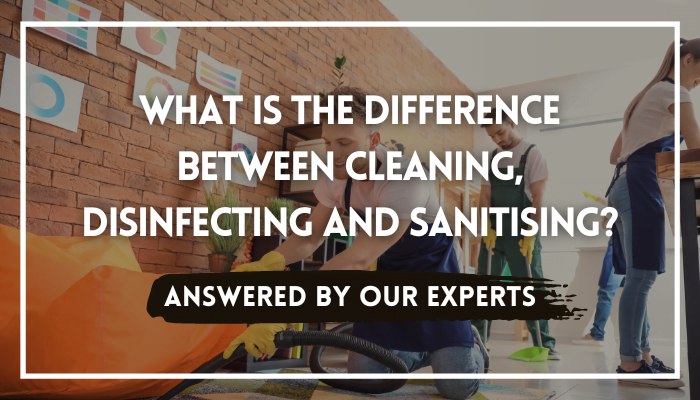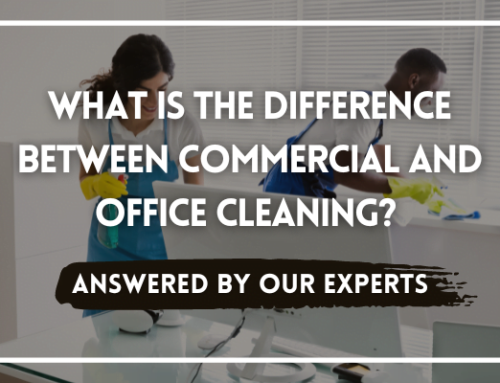When researching the right cleaning service for your business needs, do you understand the difference between cleaning, disinfecting and sanitising?
The term ‘cleaning’ can mean various things to different people, ranging from tidying toys to washing dishes. But, when it comes to maintaining a genuinely hygienic environment, we encounter three distinct categories: cleaning, sanitising, and disinfecting.
The Centers for Disease Control and Prevention (CDC) provides specific definitions for each to help us understand the level of microbial contamination left on a surface post-treatment. Understanding these terms is crucial for homeowners, assisting them in selecting the appropriate products for the right level of sanitation required in their homes. Hence, recognising the difference between cleaning, disinfecting, and sanitising is key to ensuring a safe and healthy living environment.
Defining Cleaning
Cleaning is the act of removing visible dirt, dust, and debris from a space. This process, typically involving soap or detergent and water, targets visible soiling on surfaces. Through mechanical action, such as scrubbing, cleaning helps lower the risk of infection spread by reducing the number of germs. However, cleaning doesn’t necessarily kill these microscopic organisms – this is where disinfecting comes into play.

Defining Disinfecting
Disinfecting elevates the process of germ-fighting by targeting and killing microscopic organisms like bacteria, viruses, and fungi on surfaces. This action is usually performed using EPA-approved chemicals or UV-C germicidal short-wavelength light that can disrupt the DNA of harmful organisms.
While disinfecting doesn’t necessarily clean or remove visible dirt from surfaces, it’s highly effective at killing germs, especially when preceded by cleaning.
Defining Sanitising
Sanitising bridges the gap between cleaning and disinfecting. This process reduces the level of harmful germs on a surface to a safer level, as determined by public health standards. Rather than completely eliminating all bacteria, viruses, and fungi, sanitising limits their numbers and growth, significantly reducing the risk of spreading illnesses. This process is particularly vital in spaces where these microorganisms could cause harm, such as in food preparation areas.
When To Clean, Sanitise or Disinfect
You should be able to identify when each process – cleaning, sanitising, and disinfecting – is most appropriate.
Cleaning should be a routine, consistent activity, ensuring the removal of visible dirt and reducing the number of germs. Regular cleaning can help maintain a tidy, pleasant environment and deter the growth of potentially harmful organisms.
Sanitisation becomes particularly important in communal spaces or areas prone to frequent contact, such as doorknobs, countertops, and touchpads. In places where bodily fluids may be present or in food preparation areas, sanitising is crucial to prevent the spread of food-borne illnesses.
Disinfection should be prioritised when someone in the household is unwell or if there are individuals with compromised immune systems. Remember, correctly using disinfectants is essential to achieve the desired level of germ-killing efficacy.
Following a Proper Cleaning, Sanitising, and Disinfecting Protocol
To maximise effectiveness, each cleaning, sanitising, and disinfecting task should follow a specific protocol.
- Identify the Need: Firstly, understand your specific need. Are you aiming to merely clean your space, or is there a need to sanitise or disinfect due to a specific health concern?
- Select the Appropriate Products: Once you’ve determined your need, select the right products that align with your goals. A simple soap solution might be sufficient for cleaning, while an EPA approved sanitiser or disinfectant would be necessary for sanitising and disinfecting, respectively.
- Read and Follow Instructions: Many people overlook this step, but it is crucial to ensure that the cleaning, sanitising, or disinfecting product is used correctly and to its full potential. Each product will have instructions regarding dwell time (how long the product needs to remain on the surface to be effective), the need for rinsing, and safety precautions.
- Prioritise High-Touch Areas: It’s important to prioritise frequently touched areas, including doorknobs, light switches, remote controls, mobile phones, and kitchen and bathroom surfaces. These surfaces often harbour more germs due to frequent contact and should be cleaned, sanitised, or disinfected regularly.
- Regular Maintenance: Make these practices a routine. Establishing a schedule for cleaning, sanitising, and disinfecting can help maintain cleanliness, prevent the build-up of harmful organisms, and keep your environment safe.
Final Thoughts
Understanding the difference between cleaning, sanitising, and disinfecting is fundamental to maintaining a safe and healthy environment. By recognising the right time and place for each process and following proper protocols, we can significantly reduce the risk of illness and infection in our homes and public places.
Remember, it’s not just about having a clean space but also about ensuring a safe one. Now that you’re equipped with this knowledge, you can make more informed decisions about your cleaning practices. Let’s keep our spaces not just clean but healthy too!
About Matrix Office Services
With years of experience in the industry, Matrix Office Services can provide a comprehensive solution for maintaining a clean and hygienic workspace. Our team of expert cleaners delivers professional commercial office cleaning in London.
If you want to discover more helpful tips and find the answer to common cleaning questions, read our helpful blogs and don’t forget to follow us on LinkedIn.
Contact us today to learn more about our services and how we can help you maintain a clean and welcoming business environment.






Leave A Comment